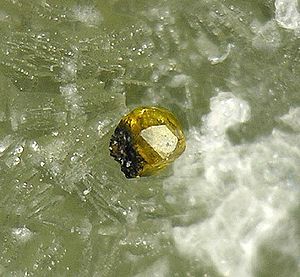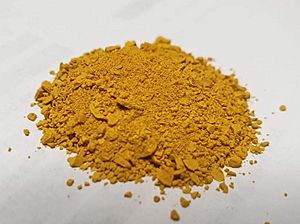Cadmium sulfide facts for kids
Cadmium sulfide is a chemical compound. It is made of two different parts: cadmium and sulfide (which comes from sulfur). Its chemical formula is CdS. This means one cadmium atom joins with one sulfur atom.
Contents
What It Looks Like and What It Does
Cadmium sulfide is a solid that can be yellow or orange. It does not dissolve in water, so it won't disappear if you put it in water. If you mix it with hydrochloric acid, it creates two new things: hydrogen sulfide gas and cadmium chloride.
Scientists have also found a cool way to use it. If you sprinkle cadmium sulfide into a special liquid that contains sulfide and then shine light on it, it can make small amounts of hydrogen gas.
Where It's Found
Cadmium sulfide is very rare to find naturally on Earth. It only shows up in two types of unusual minerals. Because it's so rare in nature, most of the cadmium sulfide we use is made by people in factories.
How It's Made
People make cadmium sulfide in different ways. One common method is to mix special cadmium salts, like cadmium sulfate or cadmium chloride, with hydrogen sulfide gas. When these chemicals meet, they create a bright yellow solid, which is cadmium sulfide.
If it's being made to use as a color (a pigment), the solid cadmium sulfide is then cleaned, heated up (to make sure it has the right shape and properties), and ground into a fine powder. After that, it can be mixed into paint.
What It's Used For
Cadmium sulfide is famous for being a bright yellow pigment. This yellow color is often called "Cadmium yellow." If another chemical called selenide is added while the cadmium sulfide is being heated, it can even make orange or reddish colors.
Cadmium sulfide is a great pigment because it stays bright for a long time. It doesn't easily break down or change color, and it doesn't react with the air like some other colors can. However, it's important to know that cadmium sulfide is harmful if you eat it or get it on your skin. So, it needs to be handled carefully.
It's also used in special devices called photoresistors. These devices can sense light, especially infrared light (which we can't see) and red light. Cadmium sulfide is also sometimes found near certain types of bacteria that change sulfate into sulfide.
Related pages
- Cadmium telluride, a material used in electronics
- Mercury sulfide, another bright red pigment, but too harmful to be used widely
- Zinc sulfide, a material that can glow in the dark
Images for kids
See also
 In Spanish: Sulfuro de cadmio para niños
In Spanish: Sulfuro de cadmio para niños




